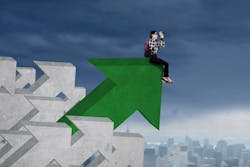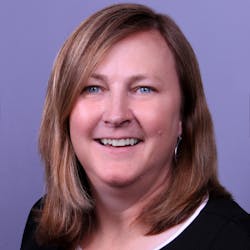ASSP President Christine Sullivan: Safety Professionals Need to Aim High
Christine Sullivan, CSP, ARM, will take the reins as the president of the American Society of Safety Professionals (ASSP) effective July 1.
She will be inheriting a ship that has been swayed by COVID-19 for the past two years. It’s impossible to know where the pandemic will lead us next, but Sullivan is already busy charting her course. She knows it won’t be easy navigating murky waters, but she is optimistic that COVID-19 has raised awareness about the role of safety professionals and has increased their influence within their organizations.
Sullivan, senior vice president and risk control director at Sompo International, has 30 years of experience in the safety profession. Her Society honors include the Charles V. Culbertson Outstanding Volunteer Service Award and Risk Management and Insurance Practice Specialty Safety Professional of the Year. She is a past vice president of the Council on Professional Development.
EHS Today caught up with Sullivan to hear more about her plans.
EHS Today: Is there any work from outgoing ASSP president Brad Giles that you plan to continue?
Sullivan: We’ve done a lot of work with Brad on DEI [diversity, equity and inclusion]. We’ve reiterated our commitment to fairness, respect, equal opportunity for all and working to become a transparent society, embracing all occupational safety and health professionals. That’s something we will continue to work on.
Are there any new initiatives that you’re planning to start?
Something that is important to me is supporting emerging professionals. There’s a lot of potential for the future growth of ASSP and the occupational safety and health profession. We really want to make sure we’re bringing people into the field.
Are you thinking in terms of retention or succession planning?
I work in the insurance industry and, similar to other industries, the safety profession is aging, so we want to make sure that we support and help these future safety professionals to become leaders—not only to be good safety people but also to be good businesspeople. How do we get them to develop business acumen, and to understand the value of building and bridging relationships? How do they grow their career in the field? That’s something ASSP can support these young professionals in.
Have you seen an increase in your membership since the pandemic started?
Actually, because of the pandemic, I would say we lost members—not because of the lack of value but because of financial constraints. They weren’t able to have company support to help them become a member. We’ve [started to see] that turn the other direction.
Are you seeing an uptick overall in the number of young people interested in becoming safety professionals?
I do some college interviews for incoming college students at my alma mater. You’re definitely seeing more people interested in the field, but kind of anecdotally. I don’t think the statistics are there yet. But, for example, we did start a new student chapter for ASSP.
I think there are a couple things. The pandemic has caused a lot of companies to reevaluate their continuity plans. Many companies had written plans in place, but they never really tested them. Nobody anticipated the number of people that would [work from] home. A lot of things hadn’t been looked at, such as overloaded networks and supply chain disruptions. There are a lot of things that came up that are going to change and [raise] the importance of planning.
The other thing that the pandemic did—and it’s something that I believe in as well—is that compliance is a bare minimum. It’s not that compliance isn’t important, but it sets a minimum standard that doesn’t really bring the business to the next level.
Hopefully, the worst is over with regards to COVID-19. What do you see as the next pressing concern?
I don’t think anybody could have predicted COVID and what the pandemic would do worldwide. I think [the next big thing] is dealing with the aging workforce, not just in the safety community, but in the workplace. It’s not new, it’s not something that has not been there, but it’s definitely something that is going to continue to impact safety professionals as they bring people into those roles.
I think AI and machine learning are going to have a huge impact on safety professionals and how jobs are done in a manufacturing facility, for example, with machine learning. How does that impact what the safety professional does? There are a lot of things out there that are going to change how people do their jobs.
What does safety mean today, and how does that compare to the past or even the future?
You have to look at safety from a lot of different perspectives. We talk a lot about worker safety, but I would also tell you safety could be a customer in a restaurant, a guest in a hotel, or a person who purchases a manufactured product. In the world [of insurance], we also have fire protection that works against keeping a building from burning down or water damage and things like that. You have to look at safety across all those areas.
You hear the term “total worker health,” and that’s another piece of it. If somebody is only safe at work and then they go home and they’re not safe at home, a lot of other pieces tie into that. Safety professionals are being asked to do more things. They’re being asked to look at a lot of different things, and their role’s constantly changing. So, a safety professional might become the person who’s working on continuity planning or some environmental issue. In my mind, the safety professional’s job is getting bigger, not smaller.
I recently saw a LinkedIn analysis that EHS specialists are the fastest growing green jobs. Do you agree with that assessment?
Absolutely. ESG (environmental, social and governance) has become an everyday word. People who didn’t know what ESG was even a year ago tend to know what it is now. I think that [will only increase] moving forward. Young professionals care about things like climate change, and they want to make an impact. I do think that ESG is a big piece of the future of safety.
Discussions about ESG are becoming more commonplace. How will EHS grow to incorporate these additional responsibilities or work with others who share them?
It’s going to depend on the organization, and it’s going to depend on the organization’s desire to make an impact. ESG has really come a long way in a very short period of time. An organization probably needs to have somebody who is really the champion for ESG. I don’t know if the safety professional is [always] that person because they need to be the champion for the risk and safety piece. I think they can partner together and work closely together, but I do think someone needs to be championing that. Safety should be a big component of it, but I do think it’s bigger than just the safety professional.
"What I tell people—and this is more on the bigger picture, both from a safety and professional standpoint—is aim high. Set your goals. Figure out where you want to be and find people who can help you get there."
Do you think that safety is becoming more representative of what the country looks like?
It’s becoming more representative, but we aren’t there yet. And that’s why DEI initiatives are so important. When I started in this field, there were very, very, very few females. I didn’t have a lot of female mentors. Most of my mentors were male. As I’ve continued in this field, I have seen the growth of females and people of other races. One of the things that I [find] really interesting is that the four major safety societies will all have female presidents this year at the same time.
Some people say they don’t want what you look like to be part of the conversation, but at the same time, representation matters. Seeing a woman, seeing a person of color, seeing someone who looks like you in a leadership role allows you to think about doing things you might not have otherwise.
Representation absolutely matters. My daughter was adopted from China and seeing people who are Chinese is important to her. She’s only 11, but she’s seeing them in different roles. There was a Marvel movie recently that had an Asian cast, “Shang-Chi and the Legend of the Ten Rings.” That’s really important. Representation does matter, whether it’s in business or everyday life.
What do you wish to see?
I don’t know that this is a wish for the safety field, but I want to see—and I hope that I show—that things are possible even when people don’t believe it. I mentioned my daughter, but I have three children. As a working mom, I’ve had a lot of people say through the years, ‘You can’t do this.’ I think it’s really important that people see that we can do this. We can be successful and have a family and have a career.
From a safety standpoint, I want to see safety professionals have a seat at the table from the C-suite. It does happen at some organizations, but not in a lot of organizations. Safety is still an afterthought in some companies. They don’t really tie profitability, quality and safety together, but they should because they all impact each other.
What advice do you have for safety professionals who are trying to espouse the benefits of safety to others?
They’ve got to be able to tie the message into the impact of the safety programs. They need to understand the finances of the organization. They need to understand what the goals are of the organization—not just the safety goals, but the organizational goals. They need to understand the total cost of risks and the impact that safety professionals can make. [In other words,] what impact can safety professionals make into the success of the organization.
Is there anything else you’d like to mention that we haven’t discussed?
What I tell people—and this is more on the bigger picture, both from a safety and professional standpoint—is aim high. Set your goals. Figure out where you want to be and find people who can help you get there. A good mentor or mentors can really help you get to different areas in your career, help you to grow in that career, and help you identify weaknesses and cultivate your strengths.
Mentoring and networking. Those are the two things I would encourage all safety professionals to do: take the time to find a mentor who can help you achieve your goals and network. Build your relationships and build your network of safety professionals because we can really help each other.
About the Author
Nicole Stempak
Nicole Stempak is managing editor of EHS Today and conference content manager of the Safety Leadership Conference.


